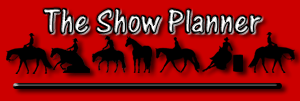 |
|
Show Horse Promotions Mary Murray
|
Toxic Yew PlantALL members of the Yew plant family are poisonous. They are beautiful but toxic and can deliver death to horses within minutes. It is the Japanese or English Yew, which is an ornamental evergreen widely used by homeowners for landscaping. In listings of poisonous plants, it is called TAXUS CUSPIDATA or TAXUS BACCATA. Six to eight ounces of leaves can kill a horse in an hour or two. It is often grown as hedges and range in height from less than 2 feet to more than 60 feet. It is dark green with needle-like foliage and a red berry that looks like a pitted olive. The berry is the only part NOT poisonous but rather the greenery, even after it has dried or died is the poisonous part. Check your home and barn for this lethal plant and be on the lookout for this plant when you travel with your horse. |
||||||||
Horse SweatHorse sweat is hypertonic, which means it has a higher concentration of electrolytes in it than blood versus human sweat, which is isotonic. Isotonic means it has the same concentration of electrolytes as blood. Electrolyte needs for routine maintenance are simple: PLAIN SALT. Horses need about 1 oz. per day of salt and most will voluntarily consume 1-2 oz. from a salt block. |
||||||||
Equine Infectious AnemiaEquine Infectious Anemia is a viral disease resulting from infection by a retrovirus similar to HIV in humans. It was know as "swamp fever" for its presence in wet areas of the country. The illness appears very quickly with a high fever, depression, small hemorrhages on the mucous membranes and swelling of the limbs, abdomen and sheath. A severe and overwhelming infection can result in death within four weeks. Once a horse is infected, he is infected for life. The form of EIA that is most problematic is that of the inapparent carrier, which is a horse that has not shown any clinical signs of the disease, yet has enough virus in his system to infect others. The United States Department of Agriculture (USDA) states statistical probabilities as follows: a.. 1/5 of a teaspoon (one-milliliter) of blood of a horse infected with acute illness of EIA contains enough virus to infect 1 million horses. By 1972, a test was developed by LeRoy Coggins and is now called the Coggins test. A sample of blood is taken to test for the antibodies to the virus. Many show events and stables will require a negative Coggins test. Before buying a horse, it is wise to have a Coggins test done and before allowing entry of any horse into a barn, a negative Coggins test should have been performed in the last 6-12 months. All horses should be tested annually for EIA. |
||||||||
Footing - Riding RingA well tended riding arena isn’t just a convenience for you; it’s a hoof and leg saver for your horse. Yet a safe, cushioned work surface requires sound design and construction and ongoing maintenance. Deteriorating surfaces send out the following signals, demanding action:
Depending on the amount of traffic in the arena, you’ll need to drag or harrow the surface weekly to monthly to smooth out the developing mounds Before using the drag/harrow, pull in the footing from under the fence or against the wall where its reachable to the equipment. If the subsurface itself has already developed berms, you’ll need to bring in heavier grading equipment to return it to level. |
||||||||
|
|
|
||||||||
